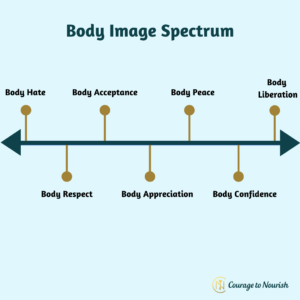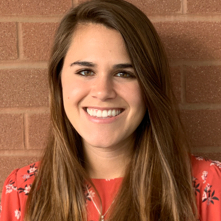When working with clients with eating disorders, supporting body image healing is often part of the conversation. With that being said, I decided to share some of my favorite body image activities for eating disorders.
Many therapists and dietitians aren’t taught how to discuss and process body image with our clients. Therefore, we have to learn on our own. Understanding various body image activities for eating disorders helps make this process easier. If you haven’t read my blog on Discussing Body Image with Clients, I’d recommend you take a look.
Also, please note that not all clients will be ready to complete the below body image activities for eating disorders. For this reason, you must use your judgement to determine whether or not a client will find these beneficial to their recovery. Some clients might need more time discussing general body image topics. They may need to feel what it’s like to live in their bodies. In that case, it must happen before diving into deeper discussion.
1. Body Image Timeline
Negative body image isn’t something that happens overnight.
We are constantly being bombarded with messages of the thin ideal. It could be representations in Hollywood such as Disney Princesses or real life actors and singers. Or dieting commercials on TV. As a result, we learn that thinness equates to beauty and health.
Each of our clients have experienced their bodies and beauty ideals in a different way at different times. When working with a client, it can be helpful for them to gain insight into how body image forms. Our culture, friends/family members, and other experiences shape its development.
Ask the client: What is your earliest memory of you becoming aware of your body? When was the first time you received the message that your body needed to change?
From there, create a timeline of various events throughout their life. Discuss these events in detail. Get curious about them. Allow your client the space to process. They also may need to grieve.
2. Respecting Your Body
The message of “love your body” has great intentions. However, for someone recovering from an eating disorder, it can be difficult to go from hating their body to loving their body.
As a result, we have to support our clients in taking smaller steps to eventually learn to love their bodies.
I often start with discussing the below body image spectrum. It represents the various “stages” of learning to love your body. I often tell clients that you don’t have to love your body in order to respect it. Body respect occurs in many different ways. For instance, eating enough, sleeping enough, drinking water, taking medications, going to the doctor…etc.

Here are some questions you can explore with clients:
1. What does “body respect” mean to you?
2. How do you currently show your body respect?
3. What other ways can you show your body respect?
4. How does your current perception of your body allow you to or prevent you from showing your body respect?
Download our body image workbook for more information on body respect. And gain access to other activities you can do with clients! Introduce a client to the Body Image Workbook Sign Up.
The foundation of having a positive body image isn’t liking or loving how you look. Rather, it’s actually knowing that your body is worthy and good regardless of how you look. Body respect is one small step in showing our bodies we have the capacity to appreciate them. Even if we don’t enjoy how we look or feel in our bodies.
Please note: When doing this activity, support clients in veering away from naming ED behaviors as “body respect.” For example: if a client says “exercise” as an example of body respect, I’d recommend to expand on that idea. Exercise is only a form of body respect if you are:
1. Not doing it obsessively.
2. Fueling enough for the amount of exercise
3. Have flexibility with exercise. For instance, not doing it when injured, not missing out on social events to exercise…etc.
3. Diversifying Social Media
Social media has made these images more visible. Which makes it all the more difficult for someone to heal their relationship with their bodies.
As previously mentioned, we are constantly bombarded with images of thin bodies as being more desirable and “healthy”.
I’d highly recommend having a conversation about social media. Begin with asking your clients how it affects their perception of themselves and their bodies. It’s critical for clients to not only recognize the pros and cons of social media, but to also diversify their feeds with all kinds of bodies.
Please check out our resources page for a starting point.
4. Thank You Letter
When was the last time you thanked your body?
Our bodies do amazing things every day to keep us alive. Things we don’t even think about! Such as blood pumping, digestion, lungs breathing, metabolizing food…etc.
Ask clients to write a thank you note to their bodies. First, ask them to remember a specific event where they remember their bodies having their backs. Examples could be catching their balance so they didn’t fall. Or their brain remembering an important detail for a test. Maybe their stomachs hurting after laughing so hard. The letter might feel superficial at first, and you can encourage clients to dig deeper.
5. Goodbye Letter
This activity might be difficult for many of our clients.
It’s writing a “goodbye letter” to their ideal body. (Or their “sick” body).
Grieving a smaller body (more muscular body, thinner body…etc.) is absolutely part of the healing process. It can be difficult to let go of the idea that achieving an ideal body might not be possible. Or even if it is possible, it would lead down a dangerous path of disordered eating and increased body distress.
Writing a goodbye letter symbolizes this grieving process. It allows clients to gain acceptance of the body they live in now.
Ask clients to include why they are saying “goodbye.” Additionally, include why they can no longer actively seek a smaller body. You can have clients include why they will miss a thinner body. Also, what they are looking forward to by accepting their “now bodies.” Allow clients space to grieve as it will be necessary for some.
6. Neutral Body Image Statements
Clients who have negative thoughts about their bodies might find it difficult to reframe those thoughts into positive ones.
In this case, instead of asking clients to simply say positive things about their bodies, we can support them in addressing negative thoughts. As well as possibly turning them into neutral ones.
First, ask clients to notice when negative thoughts come up about their bodies. Then, dig deeper and ask them how they react to those negative thoughts. Do they isolate? Body check? Does it change how they feel in their bodies?
We can support clients with more neutral language when their body image awareness has progressed. Body image awareness includes how they are talking to their bodies on a conscious and subconscious level. Help clients come up with some neutral statements. Ask them to jot these down in their phone or on post it notes.
Final Remarks
It’s also helpful and important for our clients to be seeing providers who align with the messages we are trying to give to clients. If possible, refer to providers who are eating disorder or Health at Every Size informed.
Courage to Nourish is a group of eating disorder specialized dietitians. We have in person locations in Alexandria, Virginia, Columbia, Maryland. and College Park, Maryland. We offer virtual services across the state of Virginia, Washington DC, Pennsylvania, and Colorado. We offer individual nutrition therapy. As well as support groups. We would love to guide you in building a better relationship with food.
Contact us for more information. And to schedule a discovery call. Also, sign up for our client or clinician newsletter!

Helping my clients cultivate meaningful connections and interests outside of their eating disorder is a true passion of mine. I like to think my clients and I are on a team to navigate recovery. I love working with high school and college students as well as athletes seeking to have a better relationship with exercise. I am a proud anti-diet dietitian and work with my clients through a Health At Every Size © and intuitive eating framework.

